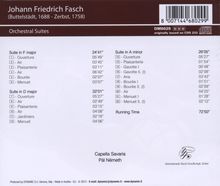Johann Friedrich Fasch: Ouvertüren (Suiten) D-Dur,F-Dur,a-moll auf CD
Ouvertüren (Suiten) D-Dur,F-Dur,a-moll
Herkömmliche CD, die mit allen CD-Playern und Computerlaufwerken, aber auch mit den meisten SACD- oder Multiplayern abspielbar ist.
Lassen Sie sich über unseren eCourier benachrichtigen, falls das Produkt bestellt werden kann.
- Künstler:
- Capella Savaria, Nemeth
- Label:
- Dynamic
- Aufnahmejahr ca.:
- 1999
- UPC/EAN:
- 8007144680299
- Erscheinungstermin:
- 1.7.2014
Ähnliche Artikel
Die Orchestersuite, „erfunden“ zur Zeit und im Umfeld des französischen Hofkapellmeisters Jean Baptiste Lully, erfreute sich in der 1. Hälfte des 18. Jahrhunderts ganz besonderer Beliebtheit. Auch Fasch folgte in seinen Suiten dem französischen Modell, das nach dem beginnenden Satz auch oft kurz „Ouvertüre“ genannt wurde. Dem folgen eine nicht festgelegte Zahl von langsamen und schnellen (Tanz-)Sätzen im Wechsel. Stilistisch ähneln die Suiten Faschs dem galanten Stil, wie er von Telemann und Graupner gepflegt wurde: unterhaltende, brillante Musik.
Product Information
The orchestral suite is a genre that was especially popular during the first half of the 18th century. It originated partly from the overtures in the style of Jean Baptiste Lully, documented from 1660, and partly from the numerous editions of Dutch suites that appeared at the end of the 17th century, and which arbitrarily collected overtures, dance compositions and arias for instrumental ensembles. Telemann, Fasch and Graupner were some of the more prolific German composers of orchestral suites.
The overtures of the orchestral suites here recorded have, in the slow and lyrical opening sections (which return, varied, at the end) all the traditional elements of the French overture, such as triad motives, dotted rhythms, and sudden scale fragments. In the fast central passages there is a more or less regular alternation between fugal sections, homophonous tutti, and contrasting solos.
Stylistically, these parts, with their sequences of short motives consisting at times of just a few notes characterised by rhythm, very much approach the galant style of Graupner and Telemann.
With its light-hearted, nimble and lively developments, Fasch’s music is both entertaining and brilliant. Among the dance compositions - the descriptive and free pieces that follow the overture - there are many, in Fasch’s suites, entitled Air. The suites in F major, A minor and D major, for example, each have two. Particularly lyrical is the fourth movement of the suite in A minor, Air largo, where Fasch proves his worth in writing creative pieces.
Plaisanterie, as the word itself says, is an amusing piece. The gay temperament of the plaisanteries, which are found especially in Fasch’s Darmstadt suites, is expressed through free rhythms and wider intervals. Of opposite mood is the bourrée, a calm and pleasant piece almost invariably beginning on an upbeat. During the 18th century this dance movement was gradually abandoned; Fasch, however, still made liberal use of it. Most orchestral suites end with the most refined of court dances, the minuet, ideally counterbalancing, in importance, the opening overture.
Disk 1 von 1 (CD)
Suite F-Dur
-
1 1. Ouverture
-
2 2. Air
-
3 3. Plaisanterie
-
4 4. Air
-
5 5. Bourée
-
6 6. Menuet
Suite D-Dur
-
7 1. Ouverture
-
8 2. Air
-
9 3. Plaisanterie
-
10 4. Air
-
11 5. Jardiniers
-
12 6. Menuet
Suite a-moll
-
13 1. Ouverture
-
14 2. Plaisanterie
-
15 3. Gavotte 1
-
16 4. Gavotte 2
-
17 5. Aria
-
18 6. Bourée 1
-
19 7. Bourée 2
-
20 8. Air
-
21 9. Menuet 1
-
22 10. Menuet 2
Mehr von Johann Friedric...
-
Mitteldeutsche Hornkonzerte - Musik aus Bachs NetzwerkCDAktueller Preis: EUR 17,99
-
Gloria Dresdensis - Orchesterwerke aus DresdenCDVorheriger Preis EUR 17,99, reduziert um 0%Aktueller Preis: EUR 7,99
-
Johann Friedrich FaschKammermusikCDAktueller Preis: EUR 7,99
-
Johann Friedrich FaschOuvertüren-SinfonienCDVorheriger Preis EUR 17,99, reduziert um 0%Aktueller Preis: EUR 7,99








